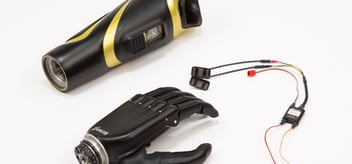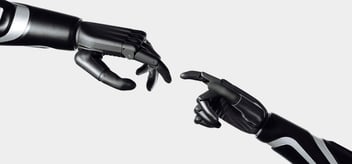Types of Upper Extremity Prosthetic Arms
Prior to formulating the prosthetic prescription for any upper limb amputee, the prosthetist must carefully assess and examine the patient’s residual limb condition with respect to different anatomical and physiological characteristics as well as various other sensory and motor examinations. Following the assessment, the prosthetist will discuss the wide range of available options and types of prosthetic componentry with the patient and the rehabilitation team, and then decide the most appropriate prescription for his/her needs.
The different prosthetic components used in any prosthetic arm generally include a socket to anchor the prostheses from the limb, a suspension system to hold the limb in place, a terminal device (a hand or a hook) that performs the activities along with different prosthetic joints such as wrists, elbows, and shoulders that provide different movements to the user.
Upper extremity prostheses differ in their functioning and also in their control mechanisms. Depending on the needs of the patient, a prosthetist may prescribe an active or passive prosthetic arm. Similarly, any user has the choice to either use his/her own body power to control the prosthetic arm or to use external sources of power to control the prosthetic arm.
Passive Prosthetic Arms
A passive prosthetic arm, as the name suggests, does not offer any movements. These passive prostheses mimic the structure of the arm, hand, and/or fingers, and are prescribed for cosmetic reasons. Their focus lies more on the aesthetic appearance of the body, rather than functionality. These prosthetic arms provide the amputees with a lightweight solution for the stabilization of objects while maintaining a normal body image. Occasionally, when required, the prostheses are equipped with joints providing a different range of movements to position the body joints at specific angles. Passive prosthetic arms often come equipped with specialized devices in place of the prosthetic hand, such as a prosthetic hook that is used for specific activities. Passive prostheses are available as either static devices or adjustable devices. Static prosthetic arms are stationary and do not move at all whereas adjustable prosthetic arms consist of an adjustable grasping mechanism or feature components that can be adjusted to different angles, by using the sound side or by pushing them against other objects.
Active Prosthetic Arms
Active prosthetic arms allow the amputee to ‘actively’ perform different motions and functions of the upper extremity. Active prosthetic arms are powered through external sources or they use the patient’s own body muscles and joints to control and move the prosthesis. These complex devices offer patients the maximum functionality and performance. They allow the patients to control the opening/closing as well as the movement of different prosthetic components, such as the prosthetic hand.
Active prostheses vary, depending on their underlying control mechanisms, such as a body-powered prosthetic arm, an externally powered prosthetic arm, or a hybrid prosthetic system.
Patients sometimes also require exclusively fabricated prosthetic arms that allow them to perform a particular task or a hobby, that is, activity-specific prostheses.
Body Powered Prosthetic Arms
In body-powered prosthetic arms, the prosthetic components are controlled by the user’s own body movements and forces. The force that is required to control and move the components is mechanically transmitted from the user’s own remaining muscles, through a strap cable attached to the target prosthetic component. For higher lever amputees (such as shoulder disarticulations) where a major portion of the limb is missing, this required muscle force is transmitted from the opposite side. Body-powered prostheses provide good tactile feedback to the user about the surrounding environment and often function as an extended limb. Such prostheses are simpler to use, are more durable, require less maintenance, and are often more cost-effective. However, the appropriate force and strength that is needed to comfortably operate the prosthetic arm depend on a number of patient factors including strength, posture, and the available motion in the anatomical joints. The major drawback of using a body-powered prosthesis is that it causes discomfort and restricts the movement of the patient due to the snugly fit cable and strap system.
Externally Powered Prosthetic Arms
Externally powered prosthetic arms make use of external sources of power to control and move the prosthetic components. These prosthetic systems provide active movements to the patient, without utilizing the patient’s own residual muscle forces. Externally powered prostheses often use sensors and other means of input to pick up electric signals from the remaining muscles. These systems consist of batteries, electrodes, motors, switches, and many other electronic components that complete the prosthetic pathway. The bio-electric signals are then amplified, processed, and changed in a manner that can be then used to control the prosthetic arm. Since these prosthetic arms are powered by external sources, their grasping strength is often greater than that of body-powered components. An essential characteristic of any externally powered prosthetic arm is that it provides a type of artificial involuntary control (a reflex) wherein the prosthetic system controls the prosthetic arm, even though the user is not aware of the decisions that are being made. Externally powered prostheses usually do not require any additional straps and encompassing cable systems to hold the prosthesis in place, therefore, they are less restrictive and allow more freedom of movement to the users. Moreover, the system can be actively operated with limited force and strength.
Hybrid Prosthetic Arms
Hybrid prosthetic arms are a combination of body-powered prosthetic components as well as externally powered components. These prosthetic arms balance the weight and cost of the prosthesis and have often shown better prosthetic outcomes. Commonly, prosthetists prefer to prescribe hybrid prosthetic arm systems to amputees with extensive limb loss, that is, a high level of amputations, as such amputees require multiple movable prosthetic components to perform their daily tasks using the prosthetic arm. The benefits of using hybrid prosthetic arms include ease of operations, light in weight when compared with a fully electronic prosthetic arm with increased grip forces, compared to that of body-powered prosthetic arms. Hybrid prosthetic arms also allow the user to simultaneously control the elbow as well as the prosthetic hand (and wrist).
Activity Specific Prosthetic Arms
Activity-specific prosthetic arms are specially designed prostheses that are used by amputees for different recreational or vocational activities, such as gardening, playing sports, fishing, heavy manual labor, swimming. Such prostheses are generally prescribed to those amputees who want to perform a specific activity but are at risk of residual limb damage due to that activity or to those amputees whose prostheses are not suitable for performing that particular activity. Hybrid prostheses consist of a specially designed socket interface, suspension system, and a terminal device that is most suitable to perform the desired activity, for example, a terminal device that has the option of attaching gardening tools or a terminal device that allows the amputee to use a fishing line. Hybrid prostheses can be passive or active, depending on the needs of the user.
The type of prosthetic system that is most suitable for any particular patient always depends on a large number of different factors and must always be decided after a thorough assessment and consensus between the user, the prosthetist, and other members of the rehabilitation team.










